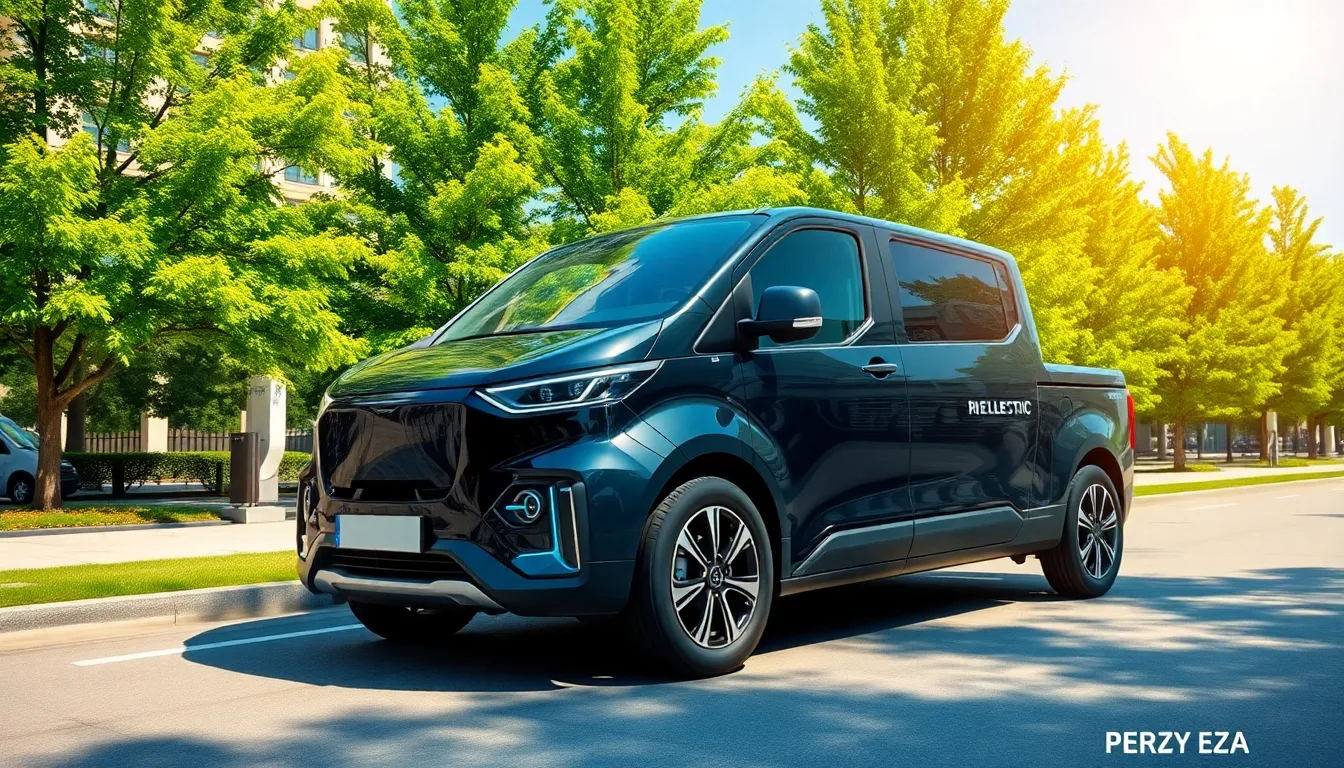When it comes to electric vehicles, most people think of compact cars zipping around town, but what if we told you that some of the heaviest hitters in the EV game weigh over 6000 pounds? That’s right! These behemoths are not just for hauling families; they’re redefining what it means to drive green while still feeling like you’re behind the wheel of a tank.
Table of Contents
ToggleOverview of Electric Vehicles Over 6000 Pounds
Electric vehicles over 6000 pounds redefine perceptions of weight in the EV market. Several manufacturers produce these robust models, catering to consumer demand for larger, family-friendly options. Examples include the GMC Hummer EV and the Rivian R1T, both showcasing durability and performance without sacrificing sustainability.
These heavy-duty vehicles often combine the utility of traditional trucks with the benefits of electric powertrains. Increased battery capacity typically provides impressive ranges, facilitating long trips without frequent recharging. Charging infrastructure is expanding, supporting the needs of heavier EVs, which can utilize high-output chargers for quicker recharges.
Performance-wise, heavy electric vehicles excel in strength and capability. Electric torque delivery allows for rapid acceleration, making them surprisingly agile. Safety features inherent in their design bolster passenger protection, another strong selling point for families.
Regulatory frameworks encourage the adoption of heavier electric vehicles too. Incentives for electric trucks and SUVs drive production, reflecting a growing market. In addition, heavy electric vehicles contribute to reducing greenhouse gas emissions, aligning with environmental goals.
With advancements in technology, battery efficiency continues to evolve. Manufacturers invest in research to enhance performance metrics, providing greater sustainability. Heavy electric vehicles present a compelling choice for eco-conscious consumers requiring space and power. These vehicles bridge the gap between ecological responsibility and powerful performance, making them an attractive option in today’s automotive landscape.
Benefits of Heavy Electric Vehicles

Heavy electric vehicles offer significant advantages across several key areas. Understanding these benefits underscores the appeal of adopting robust EVs.
Environmental Impact
Heavy electric vehicles contribute to reducing greenhouse gas emissions. They support cleaner air by minimizing reliance on fossil fuels. Innovative electric powertrains produce zero tailpipe emissions, allowing these larger vehicles to operate sustainably. Advances in battery technology enhance efficiency, further reducing environmental impact. When comparing traditional heavy-duty vehicles to their electric counterparts, the latter shows a marked reduction in overall carbon footprint. Cities benefit from decreased noise pollution, providing a quieter and more pleasant environment.
Cost Savings
Cost savings emerge as a strong incentive for consumers considering heavy electric vehicles. Owners experience lower fuel expenses due to electricity being cheaper than gasoline or diesel. While initial purchase prices may be higher, significant savings arise from fewer maintenance requirements. Electric vehicles have fewer moving parts, leading to decreased long-term repair costs. Additionally, many governments offer tax incentives and rebates for purchasing electric vehicles, further easing upfront costs. Over time, reduced operational costs can lead to considerable savings for families and businesses alike.
Considerations When Choosing Electric Vehicles Over 6000 Pounds
Selecting heavy electric vehicles involves several key factors. These factors significantly impact the overall ownership experience.
Range and Performance
Driving range plays a crucial role in the choice of heavy electric vehicles. Many of these vehicles offer ranges exceeding 300 miles on a full charge. This range often accommodates long trips without frequent recharging stops. Performance characteristics, such as rapid acceleration, stem from electric torque delivery. Heavy electric vehicles not only deliver strength but also an agile driving experience. Manufacturers are continuously enhancing battery efficiency, enabling better performance over time. Families seeking both power and practicality find these attributes particularly appealing.
Charging Infrastructure
Charging options for heavy electric vehicles are expanding rapidly. Public and home charging stations increasingly support various models. Many EV manufacturers now provide convenient charging solutions, enhancing user experience and accessibility. Availability of fast chargers minimizes downtime during long journeys. Communities invest in renewable energy sources, further promoting sustainable charging practices. Infrastructure improvements contribute significantly to overall convenience and usability for EV owners. Expanding charging networks provide confidence for consumers, encouraging broader adoption of these powerful vehicles.
Popular Models of Electric Vehicles Over 6000 Pounds
Several electric vehicles exceed 6000 pounds, showcasing impressive engineering and robust capabilities.
GMC Hummer EV stands out with its distinct design and multifunctional features. Weighing approximately 9,000 pounds, this vehicle offers up to 350 miles of range and rapid acceleration. It combines luxury with off-road capabilities, appealing to adventurous families.
Rivian R1T enters the scene next, boasting a weight around 7,000 pounds. This all-electric pickup truck emphasizes utility and performance, achieving over 300 miles of range on a single charge. Rivian highlights advanced safety features and a spacious interior for passenger comfort.
Ford F-150 Lightning has gained attention with its hefty build, weighing about 6,500 pounds. This electric version of the iconic truck maintains the functionality expected from a pickup while offering a range of up to 300 miles. Ford integrates smart technology for an enhanced driving experience and versatile cargo solutions.
Chevrolet Silverado EV emerges, with a weight around 7,000 pounds. This model combines substantial payload capacity with a range exceeding 400 miles. Chevrolet embraces electric innovation while keeping familiar design elements, making it a recognizable option for traditional truck enthusiasts.
Tesla Cybertruck captures interest with its futuristic exterior and weight over 6,500 pounds. With a range projected to surpass 500 miles, it promises impressive towing capacity. Tesla’s commitment to performance and sustainability draws eco-conscious buyers seeking unique style and utility.
These vehicles redefine expectations for electric options in the heavy-duty market. As manufacturing advances, heavy electric vehicles position themselves as compelling choices for families and businesses needing power and space.
Future of Electric Vehicles Over 6000 Pounds
Innovations in battery technology will enhance the performance of heavy electric vehicles. Improvements in chemistry and energy density aim to extend driving ranges beyond 300 miles. Manufacturers are also expanding charging networks, ensuring convenient access for users across urban and rural settings.
Safety features continue to evolve, providing advanced driver assistance systems that prioritize passenger security. Enhanced structural integrity and features like automatic braking support a safer driving experience. As these technologies advance, consumer trust in heavy electric vehicles is likely to grow.
The market is leaning towards sustainability, with efforts to reduce the environmental impacts of large vehicles. Regulations incentivizing electric vehicle ownership emphasize their role in decreasing greenhouse gas emissions. These vehicles produce zero tailpipe emissions, contributing to cleaner air quality.
Incentives influence purchasing decisions as financial support from governments becomes more prevalent. Long-term savings from fuel efficiency and lower maintenance costs make these heavy vehicles attractive investments. Consumers recognize that initial costs are offset by decreased operational expenses.
Consumer demand for space and power creates opportunities for manufacturers. Popular models, such as the GMC Hummer EV and Rivian R1T, reflect evolving preferences for functionality and luxury. The trend indicates that heavy electric vehicles are not just transportation but lifestyle choices that combine performance with eco-friendliness.
With stronger support for electric vehicles, expectations for vehicle capabilities continue to rise. Technologies focusing on renewable energy sources enhance the sustainability of charging practices. As consumer education improves, a clearer understanding of the benefits of heavy electric vehicles emerges.
Heavy electric vehicles over 6,000 pounds are revolutionizing the automotive landscape. They challenge traditional notions of what an electric vehicle can be while offering families and businesses the power and space they need. With impressive ranges and advanced safety features these vehicles not only provide performance but also contribute to a cleaner environment.
As technology continues to evolve and charging infrastructure expands the appeal of these heavy-duty EVs will only grow. Their combination of strength and eco-friendliness makes them a compelling choice for consumers looking to balance practicality with sustainability. The future of heavy electric vehicles is bright and full of potential for those ready to embrace this new era of driving.
